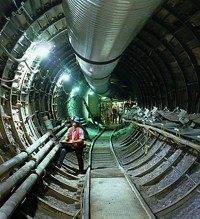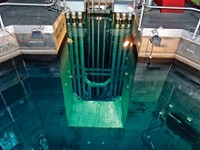Advertisement
Grab your lab coat. Let's get started
Welcome!
Welcome!
Create an account below to get 6 C&EN articles per month, receive newsletters and more - all free.
It seems this is your first time logging in online. Please enter the following information to continue.
As an ACS member you automatically get access to this site. All we need is few more details to create your reading experience.
Not you? Sign in with a different account.
Not you? Sign in with a different account.
ERROR 1
ERROR 1
ERROR 2
ERROR 2
ERROR 2
ERROR 2
ERROR 2
Password and Confirm password must match.
If you have an ACS member number, please enter it here so we can link this account to your membership. (optional)
ERROR 2
ACS values your privacy. By submitting your information, you are gaining access to C&EN and subscribing to our weekly newsletter. We use the information you provide to make your reading experience better, and we will never sell your data to third party members.
In support of nuclear power
I am responding to the recent letters on nuclear power (C&EN, Nov. 15, 2004, page 4). James W. Lewis' vague allusions to failures of nuclear power ignore the main facts of this industry, which competitively produces 17% of the world's electricity. Because of defense in depth, not every nuclear incident is a close call with public disaster.
In the early days of the industry, the U.S. built full-size reactors in five years, within budget. Japan, Korea, France, and other countries still do. Only in the regulatory madness after the Three Mile Island accident did construction times and costs escalate out of bounds in the U.S. Now that the new regulations have been thought through more carefully, construction of new reactors should proceed more smoothly.
The German pebble bed reactor THTR successfully demonstrated the important features of the fuel pebble design. These features are to be incorporated in the reactor to be built in South Africa. Less successful features, such as the hybrid turbine/generator, will be changed. The companies involved are smart enough not to invest their money in something already shown to be unsuccessful.
The Russians still have 12 Chernobyl-type (RBMK) reactors operating well. They have improved the safety systems since the disaster of 1986, but more important, they have learned their lesson not to undertake unusual operations (restarting immediately after shutdown) without advance planning and the presence of qualified personnel.
Frank J. Dinan is apparently unaware that highly radioactive spent nuclear fuel has been shipped around the country for decades. Given the extremely tough shipping casks and the ceramic composition of the fuel, it is not an attractive terrorist target. A football stadium would be much better.
For an introduction and references to the enormous amount of research on nuclear waste, I refer Mary T. Kelly to "Symposium II: The Scientific Basis of Nuclear Waste Management XXVI" (http://www.mrs.org/meetings/
fall2002/program/symposia.html), sponsored by the Materials Research Society. Nevertheless, dealing with nuclear waste is much more a political than a technical problem.
The blame for our nation's focusing on a once-through fuel cycle falls not alone on the Department of Energy but also on the many influential environmental groups who vehemently oppose uranium and plutonium recycling (reprocessing) and conversion of uranium-238 to plutonium so that it can be consumed in a reactor.
John E. Tanner Jr.
Idaho Falls, Idaho
I shan't debate deaths from future nuclear accidents, which, according to Lewis, "dwarf by orders of magnitude anything possible in the chemical industry." To date, however, the 13,000 deaths from the accident at Union Carbide's Bhopal plant have been "orders of magnitude" larger than those from the nuclear accidents at Windscale, Chernobyl, and Three Mile Island.
Unlike Lewis, I consider expansion of nuclear power to be our best hope of reducing carbon dioxide release into the atmosphere.
Edward A. White
Glenview, Ill.
Nuclear naiveté
Michael Heylin's "Nuclear Perils" correctly identified the risks of uncontrolled proliferation of nuclear weaponry (C&EN, Dec. 13, 2004, page 27). Unfortunately, his solution to the problem lacks pragmatism.
We have always known that, without preventive measures, the day would inevitably come when any nation wanting nuclear weapons would have a choice of building them or buying them. That day may be here.
Everyone agrees that the world's nations must come up with effective ways to ensure that nuclear weapons are never used irresponsibly. The problem is, how can that be done in a world where nations are sovereign and some national leaders are aggressive and hostile? Heylin's view is that the problem will be solved if all the nations that have nuclear weapons simply get rid of them. That is naive. It would work only if all the world's leaders were filled with goodwill. The nuclear genie will not go back into its bottle, because raw materials occur naturally all over the world, and technologies to make weapons out of them are well known.
So, what is to be done? Currently, the U.S. and other nations with well-controlled nuclear weapons programs maintain overwhelming nuclear superiority. They attempt to prevent nuclear "breakout" first by political persuasion but ultimately by threat of force. That approach has had some well-known failures, but it also has had some important successes. However, this method is less than ideal.
The effort of the International Atomic Energy Agency (IAEA) to prevent proliferation by enforcing the Nuclear Nonproliferation Treaty (NPT) was doomed from the start for several reasons. Many nations didn't sign the NPT, and some that did had no intention of abiding by it. Furthermore, IAEA had neither the budget and staff to do the necessary inspections nor the power to enforce compliance.
In the longer term, worldwide agreements prohibiting nuclear weapons breakouts will be necessary, but those agreements must include effective inspections and real enforcement. That could be done by a modified NPT and a strengthened IAEA. Until that day comes, it would be helpful if the states that have nuclear weapons secured more active support for proliferation control from nonweapons nations than they are now getting.
Susan Wood and Dean Sackett
Aiken, S.C.




Join the conversation
Contact the reporter
Submit a Letter to the Editor for publication
Engage with us on Twitter